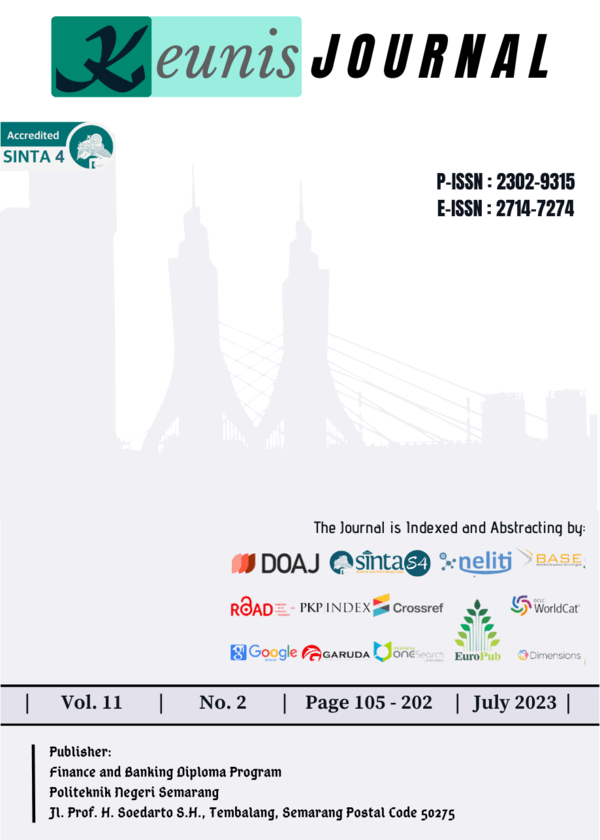IMPLEMENTATION OF INFORMATION TECHNOLOGY IN FINANCIAL SYSTEM AT UNIVERSITY X
DOI:
https://doi.org/10.32497/keunis.v11i2.4199Keywords:
Technology Innovation, Accounting Information SystemAbstract
The rapid development of technology requires organizations to keep up with innovation in order to achieve competitive advantages. University X is a university that is beginning to prepare for this wave of change by implementing a system in the financial transaction process. This study aims to analyze the application of information technology in the financial system at University X. The data collection approach used in this study is the interview method. It is a qualitative descriptive study that uses primary data. The respondents in this study were those who were directly involved in the transition process from manual work before 2011 to using the new IFS system in 2022, including the Deputy Chancellor for Finance, Head of Finance, Staff of the Salary Section of the Finance Section, Staff of the Bookkeeping Section of the Finance Section, and System Staff in the HR Section. The results of the analysis can be concluded: before 2011, a manual system was implemented, then from 2011 to 2016, an intranet system was implemented; from 2016 to 2018, the development was intranet system A; from 2019 to 2020, the K-system; and from 2022 until now, IFS. However, before 2019, the payroll division was still worked out manually using simple Excel and printed payslips. From 2019 to 2020, a new system was implemented that could provide notifications of expired allowances. The findings in this study can be used to assist universities dealing with technological changes, especially in the process of implementing a new financial system so that it can be accepted by its users and, moreover, the system is actually implemented successfully in an organization.References
Astuti, N. M. M. P., & Dharmadiaksa, I. B. (2014). Pengaruh Efektivitas Penerapan Sistem Informasi Akuntansi, Pemanfaatan dan Kesesuaian Tugas pada Kinerja Karyawan. Jurnal Akuntansi Universitas Udayana, 9(2), 373”“384. Retrieved from file:///C:/Users/user/Downloads/9148-1-20165-1-10-20141113.pdf
Calder, A. M. (2013). Organizational Change: Models for Successfully Implementing Change. Undergraduate Honors Thesis, 1”“20. https://doi.org/https://doi.org/10.26076/c90a-83f5
Damanpour, F. (1991). Organizational Configurations and Performance: a Meta-Analysis. Academy of Management Journal, 34(3), 555”“590. https://doi.org/10.2307/257028
Dita, M. A. dan I. W. P. (2016). Pengaruh Penerapan Sistem Informasi Akuntansi Terhadap Kinerja Karyawan Dengan Integritas Karyawan Sebagai Variabel Pemoderasi. E-Jurnal Akuntansi, 15(1), 614”“640. Retrieved from https://ojs.unud.ac.id/index.php/Akuntansi/article/view/17695/13433
Galindo, A. and M. M.-D. (2002). Information and computation: Classical and quantum aspects. Reviews of Modern Physics, 74(2), 347”“423. https://doi.org/10.1103/RevModPhys.74.347
Hidayat, M. (2013). Analisis Penerapan Sistem Akuntansi Penggajian dan Pengupahan Dalam Mendukung Pengendalian Intern (Studi Kasus pada PT. Cahaya Marta Perkasa, Pamekasan). Jurnal Administrasi Bisnis (JAB), 6(2). Retrieved from http://administrasibisnis.studentjournal.ub.ac.id/index.php/jab/article/view/300
Jamaludin, F. (2018). Masih Minim Perguruan Tinggi Melakukan Transformasi Digital. Retrieved January 13, 2022, from www.merdeka.com website: merdeka.com/teknologi/masih-minim-perguruan-tinggi-melakukan-transformasi-digital.html
Junaid, I. (2016). Analisis Data Kualitatif Dalam Penelitian Pariwisata. Jurnal Kepariwisataan, 10, 59”“74. Retrieved from http://repository.poltekparmakassar.ac.id/123/1/Analisis data Ilham Junaid.pdf
Kabuhung, M. (2013). Sistem Informasi Akuntansi Penerimaan Dan Pengeluaran Kas Untuk Perencanaan Dan Pengendalian Keuangan Pada Organisasi Nirlaba Keagamaan. Jurnal Ekonomi Dan Bisnis, 1(3), 339”“348. https://doi.org/10.1017/CBO9781107415324.004
Luhur, P. A. (2018). Unika Soegijapranata Siap Sambut Era Disruptif. Retrieved March 17, 2022, from www.suaramerdeka.com website: https://www.suaramerdeka.com/semarang-raya/pr-0439698/unika-soegijapranata-siap-sambut-era-disruptif?page=all
Maroep, M. (2009). Penerapan Sistem Informasi Akuntansi Penjualan pada PT Indomobil Surabaya. Jurnal Ekonomi Bisnis, 214”“223. Retrieved from http://fe.um.ac.id/wp-content/uploads/2010/01/maxi-maruf_5.pdf
Mekari. (2019). Wajah Baru Strategi HR di Era Industri 4 . 0. Retrieved from https://www.talenta.co/ebook/strategi-hr-di-industri-4-0/
Mellita, D., & Elpanso, E. (2020). Model Lewin Dalam Manajemen Perubahan Teori Klasik Menghadapi Disrupsi Dalam Lingkungan Bisnis. Mbia, 19(2), 142”“152. https://doi.org/10.33557/mbia.v19i2.989
Ni”™mawati, & Zaqiah, Q. Y. (2020). Proses Inovasi Kurikulum: Difusi dan Diseminasi Inovasi, Proses Keputusan Inovasi. MISYKAT: Jurnal Ilmu-Ilmu Al-Quran, Hadist, Syari”™ah Dan Tarbiyah, 5(2), 81. https://doi.org/10.33511/misykat.v5n2.81-98
Pranata, O. dkk. (2018). Pengaruh Pelatihan Terhadap Kompetensi dan Kinerja Karyawan (Studi Pada Karyawan Tetap di PT Bank Tabungan Pensiunan Nasional Syariah Malang Divisi Mobile Marketing Syariah ). Jurnal Administrasi Bisnis, 61(3), 39”“47. Retrieved from http://download.garuda.kemdikbud.go.id/article.php?article=750484&val=6468&title=PENGARUH PELATIHAN TERHADAP KOMPETENSI DAN KINERJA KARYAWAN Studi pada karyawan tetap di PT Bank Tabungan Pensiunan Nasional Syariah Malang Divisi Mobile Marketing Syariah
Winardi, J. (2005). Manajemen perubahan. Jakarta: Prenada Media.
Riyadi, M. K., & Huseini, M. (2019). Inovasi Sistem Manajemen Kinerja Sdm Terintegrasi Dengan Big Data Di BPJS Kesehatan. Jurnal Wira Ekonomi Mikroskil, 9(1), 35”“44. https://doi.org/10.34010/jurisma.v9i1.1528
Rosdiana, N., & Aslami, N. (2022). The Main Models of Change Management in Kurt Lewin”™s Thinking Model-Model Utama Manajemen Perubahan dalam Pemikiran Kurt Lewin. Jurnal Akuntansi, Manajemen Dan Bisnis Digital, 1(2), 251”“256. https://doi.org/https://doi.org/10.37676/jambd.v1i2.2446
Semiawan, C. R. (2010). Metode Penelitian Kualitatif. Retrieved from https://books.google.co.id/books?hl=id&lr=&id=dSpAlXuGUCUC&oi=fnd&pg=PA2&dq=Metode+Penelitian+Kualitatif+&ots=_zQ9AFLQM1&sig=gZF9oN0u8hUIqXF1F2GJAXQMshk&redir_esc=y#v=onepage&q=Metode Penelitian Kualitatif&f=false
Sudaryono. (2017). Metodologi Penelitian. Depok: PT Rajagrafindo Persada.
Sugiyono. (2016). Metode Penelitian Kuantitatif, Kualitatif dan R&D (Cet.23). Bandung: Alfabeta.
Suhud, S. P. (2015). Pengaruh Penerapan Sistem Informasi Akuntansi Terhadap Kinerja Individu Pegawai Distro Di Kota Bandung. Retrieved from http://eprints.undip.ac.id/46388/1/18_SUHUD.pdf
Suryajaya, H. A. (2015). Proses Inovasi Minuman Kopi Pada Kafe Monopole. Agora, 3(1), 343”“352. Retrieved from http://download.garuda.kemdikbud.go.id/article.php?article=1241368&val=6509&title=PROSES INOVASI MINUMAN KOPI PADA KAFE MONOPOLE
Unika Soegijapranata Jadi Universitas Transformasi. (2018). Retrieved December 15, 2020, from news.unika.ac.id website: https://news.unika.ac.id/2018/08/unika-soegijapranata-jadi-universitas-transformasi
Wijaya, H. (2018). Model Proses Inovasi Rogers dalam Organisasi. Reasearch Gate Online Journal, (June), 1”“20. Retrieved from https://www.researchgate.net/profile/Hengki-Wijaya/publication/325527346_Model_Proses_Inovasi_Rogers_dalam_Organisasi/links/5b122abfa6fdcc4611dbf8fc/Model-Proses-Inovasi-Rogers-dalam-Organisasi.pdf
Downloads
Published
Issue
Section
License
KEUNIS is licensed under a Creative Commons Attribution-ShareAlike 4.0 International License.
Authors who publish with this journal agree to the following terms:
- Authors retain copyright and grant the journal right of first publication with the work simultaneously licensed under a Creative Commons Attribution-ShareAlike 4.0 International License that allows others to share the work with an acknowledgement of the work's authorship and initial publication in this journal.
- Authors are able to enter into separate, additional contractual arrangements for the non-exclusive distribution of the journal's published version of the work (e.g., post it to an institutional repository or publish it in a book), with an acknowledgement of its initial publication in this journal.
- Authors are permitted and encouraged to post their work online (e.g., in institutional repositories or on their website) prior to and during the submission process, as it can lead to productive exchanges, as well as earlier and greater citation of published work (See The Effect of Open Access).






